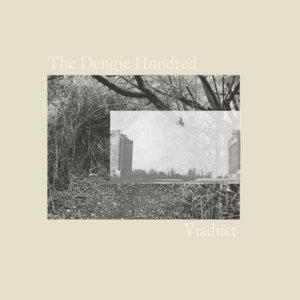Viaduct by The Dengie Hundred

AST163: The Dengie Hundred - Viaduct c38
London's The Dengie Hundred is one of the few contemp projects that has organically drawn me into its orbit, across a slew of rather disparate releases spanning the last few years. There is the closest realisation of post punk in 2022's Brackenbank, a monolithic post-Broken Flag esoteric excursion in 2023's Lammas Land and, more recently, the subtle and eviscerated dream-pop leans of Dengie's 2024 collaboration with writer and singer, Gemma Blackshaw.
The Earth's various competing repulsions and attractions fortuitously decided to link myself and the entity behind The Hundred without a great deal of effort required on either part.
One of those connections that already feels as timeless as the rocks. A release was quickly suggested and furnished, it being the two longform pieces that make up the Concept Cassette, Viaduct.
For me, the most obvious reference point that comes to mind for The Dengie Hundred is Mark Fisher's work on myth, hauntology's forgotten futures and the cultural eddy of England's past. So, by extension, you can easily connect Dengie to everything from the foregrounded spectrality of The Caretaker to the radiant afterglow left in the wake of post punk. All of this is to say that The Dengie Hundred is very English. Also, that he/they/it operates in the shadows of various esoteric musical movements, but still evokes its own distinctly vaporous form, in spite of the murk in which it cloaks itself. At times, I also hear a shared affinity with the kind of storytelling, social commentary and sonic uneasiness present in the work of domestic sound-sorcerers, Red Wine and Sugar.
This aspect of bardic, peripheral narrative is none more evident than on Viaduct. In one sense, it's almost forty minutes is a radio-play meditation on regional English masculinity, myth and the murk of history. There are rather subtle nods to post punk adjacency in its occasional, processed guitar, but largely Viaduct is much more concerned with psychogeographical atmos. It's chemistry leaning on obfuscated field recording and a densely entwined strata of miniature elements.
The release is centred on a specific event, whether fully real or imagined is not hugely important, but is vital a catalyst as any, providing a jump-off point into investigation of place, memory and all that this may entail. For this reason, I have included The Dengie Hundred's essay on the significance of Viaduct as a poster with the release (and, somewhat begrudgingly, below). It's not to say that the album can't resonate without context, but the substance of its inspiration only adds further weight to what is already a heady affair.
Despite the seeming bluelit illumination of every pocket of existence, some aspects of the past (present, future...) don't necessarily become any clearer for the glare. This is where the role of the stoyteller, the interpreter, the creative interlocutor excels. This is as good a crossing point as any into the Dengie Hundred.
~ ~ ~ ~
An estuary tale of motorcycles, myth and masculinity
Maldon, the small Essex market town that I grew up in, was once part of a national rail network, the result of a Victorian expansion of branch lines that threaded together communities and industries across England. The Eastern Counties Railways company began work on this in 1847. It was open for passenger travel just one year later.
One particularly impressive piece of this infrastructure was the viaduct that connected Heybridge to Maldon over the River Chelmer. This huge construction with vaulted arches had its foundations in the thick, sticky estuary mud in an area that is still prone to flooding at each high spring tide. The line closed to passengers in 1964, a victim of the rise of the motor car. The middle part of the viaduct was blown up by explosives shortly after, leaving just the intricate, grey-bricked arches.
By the time I was growing up in Maldon in the 1980’s the impressive and ornate railway station just out of town had been repurposed as a wine bar and disco, handily illustrating the differences in civic and social aspirations between the 1880’s and the 1980’s.
The railway line itself had been removed, but you could follow the path it cut on foot; a long section became a favoured route for dog walkers. The sidings where the tracks ran remained. If you scuffed down a few inches with your heel you would find pieces of Victorian pottery, or if you were lucky an almost whole clay pipe. Rubbish from London had been shipped down the line to provide ballast for this work. Amateur excavations added to the sense of abandonment and decay: domestic lives shipped down the line, forgotten.
At the end of this path was the viaduct, by this time crumbling and overgrown, but a haven for the older kids who had gotten into weed, acid and Pink Floyd, if the graffiti sprayed up the sides of the arches was anything to go by. I distinctly remember the graffiti on one long slab of stone that had been abandoned there, hinting that it was a grave that covered the remains of a previous visitor. This was probably hilarious to the stoners as they wrote it, but it scared the crap out of me at the time and still does a little when I think about it.
It was a place for experimentation and fumbling, a world that I could only visit as a curious boy after the event, sifting through the aftermath. As I got older, I heard a rumour about the viaduct, the 80-foot gap had once been jumped on a motorbike by Eddie Kidd.
Eddie Kidd was about as big as celebrity got in the 1980’s, a fresh-faced stunt driver who was appearing in films as a stunt double by his early twenties. He was a regular face on TV at the time, often jumping a row of buses, or through rings of fire. His nemesis was the American daredevil Evil Knievel who had a similar schtick. Our Eddie didn’t have the same Las Vegas largesse. He was clean cut and acceptable to parents, the perfect celebrity for the age.
Faster… Higher… Bigger…
This was pre-Internet, so if a bloke told you something in a pub the believability of the account was based on if other people had heard the same story, or the reliability of the story teller. The most enduring myths grow in these environments, and this story was repeated often enough and by enough sources to lend it some credibility.
I hadn’t thought about it for years, but producing music as The Dengie Hundred (an old demarcation of an area in Essex that includes Maldon) has made me revisit the area, its geography and stories. I looked up the jump on Google and was surprised to find not only photographic evidence of the jump, but also film footage.
The black and white photography was particularly evocative, Eddie Kidd as a twenty-year-old, suspended mid-air, halfway across the blown out span of the bridge, suspended not only in an impossible space, but also in time and in his (and my) youth. In the picture Kidd is jumping away from Maldon and into The Dengie Hundred, the river providing the boundary line.
The photo spoke of the industrial decline of Essex, and also the dominance of the combustion engine over the steam engine. Here, writ large in an act of pure bravado and leather clad virility, Kidd later told an interviewer that he “did it my way” while onlookers described it as reaching the summit of “Essex’s Everest”. This is the language of adventurers: those who tread the line between heroism and serious injury or death.
The jump was captured as part of the film Riding High, which was to launch Kidd as actor. The screenwriter Derek Ford described it as a “lousy picture”. The reviews were no better with one critic writing that it was “not so much a film as an excuse to show off Kidd’s madcap motorcycle stunts”.
It is on Netflix in the UK, so you can judge for yourself… But who wouldn’t want to see legendary character actor Irene Handl rolling her eyes as Eddie Kidd jumps her front garden, or an extended sequence set to a soundtrack of The Police where Kidd jumps the breakwaters on an Essex beach at sunset?
The climax of the film is the Viaduct jump, a stunt so risky that the film was shot with two endings, one for a successful jump, one in reserve in case the jump went wrong so that the film could still be salvaged. This feels pretty callous until you read that the funding for the film had run out before completion, so more money was borrowed by the producer’s father from the criminal fraternity. Kidd was not the only one risking life and limb to get the project finished.
Luckily, no such risk has been made in making this album.
In making this music, I tried to bring all these elements together: the eeriness of the landscape; the bravado of the stunt driver; that moment, mid jump, where a landing might be soft or catastrophic; sounds of leather, motorbike chains, engines.
In the summer of 2024 I returned to Maldon. The old railway line has been repurposed as a ring road that now bypasses the town. What remained of the viaduct was removed; a new road bridge crossing the river takes its place. I followed a new path that leads down to the river from the road and under the bridge. I made a set of field recordings there: a flock of wading birds that I had disturbed and the rolling thrum as cars cross the water, following the trajectory of Kidd, but cocooned in their family sedans.
I was really pleased to see that the bridge is evidently still a meeting ground for the stoned and bored. Graffiti blooms and melts into moss – messages for friends, for lovers, for the pharmaceutically adventurous. An intersection where the land becomes mud, tucked away from the norm, it can be scary but it is a place where myths are made – where, if you scuff your heels, you can find broken pieces of history.
A crossing point, into The Dengie Hundred.
~ ~ ~ ~
Tracklist
| 1. | A Untitled [Side 1] | 18:16 |
| 2. | B Untitled [Side 2] | 19:00 |
Credits
All music by The Dengie Hundred
Mastered by Carim Clasmann at The Fishtank, Cologne
Design by CB







